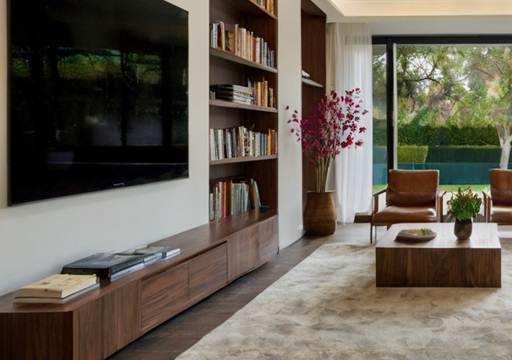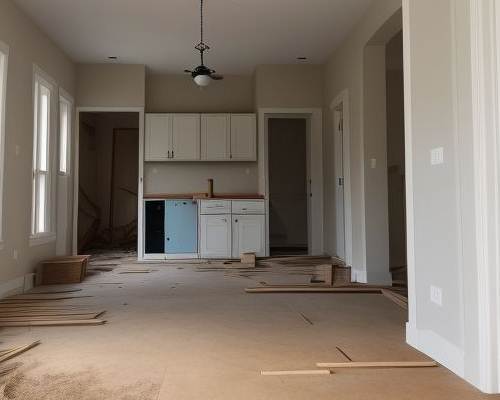TORRENT
WATCH
House renovation in Malaysia is an essential part of home-ownership, reflecting the need to adapt and update living spaces to meet evolving needs and preferences. In Malaysia, the tropical climate, cultural influences, and the diverse architectural styles create unique ideas for homeowners looking to renovate. Understanding why renovations are necessary and how to approach them effectively can make the entire process smoother and more rewarding.
Whether you’re updating balcony area or undertaking a full-scale renovation project, the journey involves careful planning, creative vision, and practical execution. Let alfabina, Kuala Lumpur Trusted Contractor explore every aspect of house renovation, from initial planning to final touches, design inspiration and estimate pricing.
Necessity of doing House Renovation
Over time, every house experiences wear and tear. Walls start to show change color with paint peeling off and colors fading. Tiles in the kitchen and bathroom can crack, creating not only an unsightly appearance but also potential safety hazards. Plumbing and electrical systems, which are often out of sight, can degrade over time, leading to leaks or inefficient energy use. These issues are not just cosmetic, they can significantly impact the safety, functionality, and comfort of your home. Regular maintenance and timely renovations are crucial to addressing these problems before they escalate into high cost repairing.
House renovation also allows homeowners to modernize their living spaces. Changing design as what was considered stylish a decade ago may now feel outdated. Renovating your house provides an opportunity to refresh it with contemporary aesthetics and opportunity to install new technologies. As many modern electrical appliances might need different type of wiring installation.


How Much Does Malaysia Home Renovation Cost ?
When it comes to house renovation in Malaysia, costs can vary widely depending on different factors. The scope of the renovation plays a significant role in determining the overall expense. For example, minor renovations like painting might cost anywhere between RM4,000 all the way to RM20,000. This range typically covers small improvements or cosmetic updates and take less time to complete.
Bigger house renovations, like significant structural changes, adding partitions to create rooms, or a complete home makeover, can exceed RM100,000 and, in some cases, reach several hundred thousand ringgit. These extensive projects often require comprehensive planning, high-end materials, and specialized labor, contributing to their higher cost. The final expense will depend on the complexity of the work and the specifics of the renovation. For custom renovations, where homeowners seek bespoke designs or unique features, costs can be particularly high due to the personalized nature of the work and the premium materials often used.
Here’s an example estimation breakdown of renovation costs for a standard 3-bedroom terrace house in Kuala Lumpur Malaysia.
- Demolition and Preparation: RM 5,000
- Structural Work (if any): RM 10,000
- Electrical and Plumbing: RM 15,000
- Flooring (tiles or laminate): RM 12,000
- Kitchen Renovation: RM 20,000
- Bathroom Renovation (each): RM 8,000 x 2 = RM 16,000
- Painting: RM 5,000Furniture and Fixtures: RM 10,000
- Contingency (10% of total): RM 11,300
- Total Estimated Cost: RM 104,300
Above pricing is only an estimation as the pricing will be lower / higher depending on the square feet of the house , the difficulty of the project and the length the house renovation project needed to be completed.
Different part of House Renovations in Malaysia that’s normally done.
- Updating flooring, walls, and ceiling
- Installing new lighting fixtures
- Replacing or refurbishing furniture
- Adding built-in shelves or storage units
- Upgrading entertainment systems
- Replacing cabinets and countertops
- Installing new appliances
- Updating flooring and backsplashes
- Enhancing lighting
- Adding an island or breakfast bar
- Upgrading fixtures such as sinks, toilets, and bathtubs
- Replacing tiles and flooring
- Installing new vanity units and storage
- Enhancing lighting and ventilation
- Adding luxury features like heated floors or a spa shower
- Installing built-in wardrobes and storage
- Adding features like a reading nook or home office space
- Improving insulation and soundproofing
- Creating a dedicated workspace with built-in desks and storage
- Upgrading electrical outlets and internet connectivity
- Improving lighting and ergonomic furniture
- Adding soundproofing for a quieter environment
- Replacing furniture
- Adding storage solutions like cabinets or buffets
- Finishing unfinished spaces
- Adding living areas such as a family room or guest bedroom
- Installing a home theater or gym
- Improving insulation and waterproofing
- Adding a laundry room or additional bathroom
- Converting into a usable living space such as a bedroom or office
- Adding insulation and proper ventilation
- Installing skylights for natural light
- Enhancing access with better stairs or ladders
- Converting into additional living space
- Adding storage solutions
- Improving flooring and insulation
- Installing new doors and windows
- Creating a workshop or hobby area
- Renovating patios, decks, and porches
- Landscaping and garden improvements
- Installing outdoor kitchens or dining areas
- Adding swimming pools or hot tubs
- Building gazebos, pergolas, or other structures
- Installing better lighting
- Adding storage solutions like coat racks or benches
- Improving door and window designs
- Upgrading appliances
- Adding storage and organization solutions
- Improving flooring and wall finishes
- Enhancing lighting and ventilation
- Replacing or repairing roofing materials
- Updating siding or exterior finishes
- Improving insulation and weatherproofing
- Painting or adding new cladding
- Replacing old windows and doors with energy-efficient models
- Updating frames and trims
- Adding security features
- Improving insulation and weatherproofing
In Case You are looking for Contractor Doing Renovations for all the above?
We here at alfabina ( A Professional Cheras Contractor Company) got you covered.
Now Lets Continue on where we left of.


Planning Your House Renovation Project and Navigating Malaysian Renovation Rules and Regulations, especially permits.
In Malaysia proper planning ensures a smooth renovation process, while understanding local regulations prevents legal complications down the road. Let’s see how to effectively plan your house renovation and getting the necessary regulations and permits.
The very First step is Planning Your House Renovation
Define Your Goals: What do you hope to achieve with the renovation projct? Understanding your objectives will guide your planning process and help you make better decisions.
Set a Budget: Establishing a realistic budget is crucial. Consider the costs of materials, labor, permits, and unexpected expenses. It’s advisable to include a contingency fund of around 10-15% of your total budget to cover unforeseen costs. Being clear about your financial limits from the start will help you make cost-effective choices and avoid overspending.
Create a Detailed Plan: Develop a comprehensive plan outlining the scope of work. This should include specifics about what areas of your home will be renovated, the materials to be used, the timeline for each phase of the project, and the overall completion date. A detailed plan acts as a roadmap, ensuring that every aspect of the renovation is considered and organized.
Research and Hire Professionals: The success of your renovation heavily depends on the professionals contractor you hire. Research and select Malaysia contractor, architect, and designer with a strong reputation and relevant experience. Obtain multiple quotes and review their past work. Clear communication with your chosen professionals is essential to ensure that your vision is understood and executed correctly.
Getting Malaysian Renovation Regulations and Permits
Understand Local Regulations: Malaysia has specific regulations governing house renovations, which vary by locality. For example, if you are located under the area covered by , then obtaining permit from them is necessary. Of-course this actually depends on the renovations project scale as well.
Submit the Needed Documentations: Once you’ve identified the required permits, prepare and submit the necessary documentations. This typically involves providing detailed plans and specifications of the proposed work. In some cases, you might need to include floor plan, structural calculations, and other technical documents. Ensure that all submissions meet the council’s requirements to avoid delays.
If you are looking to create a detail floor plan for your renovation project, We Alfabina can help as well.


Design and Inspiration
Do you know that at the moment, these 3- Modern, Contemporary and Minimalist is the most sought after design?
The design phase is where your renovation dreams take shape. Whether you prefer sleek modern aesthetics, rustic charm, or timeless elegance, this is the time to define your style and gather inspiration.
Choosing a Design Style: Explore design magazines, websites, and social media platforms especially Pinterest and instagram to discover styles that resonate with you. You can then use your favourite design as inspiration.
Starting Your Interior Renovation
Interior renovations breathe new life into living spaces, enhancing comfort and functionality for daily living. Below are the most important area where house renovation project takes place.
Kitchen Renovation: The kitchen is often the heart of the home, where families gather to cook, eat, and socialize. Consider open-plan layouts, custom cabinetry, energy-efficient appliances, and durable countertops. Maximize storage with pull-out shelves and organizational systems that streamline meal preparation and cleanup.
Bathroom Renovation: Upgrading bathrooms with spa-like amenities, such as walk-in showers, soaking tubs, and heated floors. Choose moisture-resistant materials and fixtures that withstand daily use. Install efficient ventilation systems to prevent mold and maintain air quality.
Living Room and Bedroom Renovation: Creating inviting spaces for relaxation and entertainment with comfortable seating, versatile storage solutions, and stylish accessories. Experiment with color palettes, textures, and furniture arrangements to reflect your personal style and maximize usability.
Flooring Installation: Select flooring materials that complement each room’s function and aesthetic. Options include hardwood, laminate, tile, vinyl, and carpeting. Consider factors such as durability, maintenance requirements, and noise reduction when choosing flooring for different areas of your home.
Lighting Design and Installation: Illuminate living spaces with layered lighting techniques that enhance ambiance and functionality. Incorporate overhead fixtures, task lighting, and accent lights to create focal points and highlight architectural features. Explore energy-efficient LED bulbs and dimmer switches for customizable lighting levels.
House Renovations is surely one of the very much popular category when it comes to where people spends their money on. By understanding popular renovation areas and design styles, and by collaborating with an experienced contractor company, homeowners can achieve successful renovations that improve their home’s functionality, style, and value. With careful planning and expert guidance, the renovation process can lead to a beautifully transformed home that meets both practical needs and showcase of beauty.
#Malaysia Contractor, #KualaLumpur_Contractor, #House Renovation #alfabina